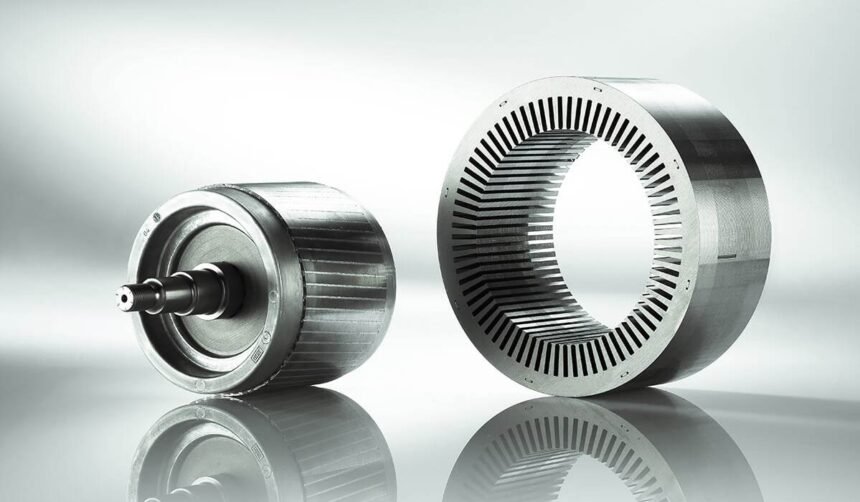Steel laminations play a crucial role in electromagnetic assemblies and the motor’s core structural design. Motor and generator performance depend on low-loss materials that preserve magnetic flux paths. The selection of genuine and durable materials ensures long service life and stable operation of the equipment daily. Electrical conductivity demands attention since any unwanted resistance can raise the temperature and reduce efficiency.
Electrical steel laminations provide optimized pathways for magnetic flux while controlling eddy currents. In this context, core losses reduce when sheets align properly and insulation layers maintain integrity. Design engineers and procurement teams seek materials that balance cost, efficiency, performance, and sustainability objectives. This article will enrich your knowledge about material selection, quality control, and transformer design.
Optimize Magnetic Flux Direction For Lower Loss
In transformer core design, silicon steel sheets help magnetic flux find the easiest path through the metal. They use a grain-oriented structure, so internal grains align in one direction, which ultimately enhances flux flow. That alignment limits hysteresis and eddy current losses substantially in high-power systems. With proper design, the machine operates cooler, quieter, and with improved energy efficiency.
When you choose laminations with correct grain orientation, the core enjoys low reluctance paths for flux movement. Such an approach ensures less wasted energy, fewer stray magnetic fields, and improved performance overall. The laminated sheets also maintain strong electrical conductivity, combined with superior magnetic behavior compared to standard steel. The performance gains in size, weight, and sound emission can be realized through reduced losses.
Select The Right Material Grade To Match the Application
Material grade plays a critical role in how well magnetic core laminations perform within a transformer core. Recognized grades, such as M15, M19, M22, M27, M36, and M45 cover different applications and duty cycles. Selection of a lower core loss grade secures long-term savings in energy cost and better thermal behavior under load. The ideal grade choice ensures your transformer design meets performance targets without excess size or weight.
Different operating conditions call for different lamination grades for optimal results. For example, a power distribution transformer may need grain-oriented steel with extremely low loss characteristics. However, a smaller machine with a moderate load might accept a more cost-effective grade. The key is to match the material specification to your real application environment and duty cycle.
Mind The Lamination Thickness, It Affects Core Performance
The thickness of each lamination sheet influences how much eddy current circulates. Thinner sheets reduce the loop area for eddy current flow, so losses drop and efficiency goes up. However, thinner laminations tend to cost more in processing, stamping, and coating, so a trade-off exists. Your transformer design must balance manufacturing cost with efficiency gains and weight reduction benefits.
Lamination thickness also affects the stacking factor, mechanical stability, and vibration behavior inside the core assembly. If sheets are too thin, you may face handling issues, tolerance challenges, or insulation breakdown in large cores. Conversely, thicker sheets may ease fabrication but compromise performance in high-efficiency systems. In short, you must select a thickness that fits the size rating budget and efficiency targets for your design.
Use Stamping Precision And Proper Stacking
Precision in stamping and die tooling ensures each lamination fits precisely and maintains its insulation coat. Poor stamping might distort laminations, misalign magnetic paths, or compromise insulation between layers. Proper stacking and alignment preserve the performance advantages of transformer core materials. The outcome is a transformer core that works reliably, quietly, and over its lifespan.
The assembly process matters as much as the raw material grade and thickness when transformer design is considered. When laminations are stacked with tight tolerances and consistent insulation, you avoid hotspots, vibration sources, and long-term fatigue. That attention to detail supports better mechanical strength, lower noise, and higher lifespan for the machine. The assembly quality thus amplifies the benefits of your material choice in the finished product.
Improve Core Loss And Efficiency Through Material
Efficient transformer design goes beyond selecting steel; it also involves how laminations are treated. Proper annealing, insulation coating, and stacking methods enhance the magnetic and mechanical properties of the core assembly. With treated laminations, the machine runs cooler, wastes less energy, and delivers stronger performance under load. The value arises when you work with a material or process partner who understands these capabilities in depth.
The expertise in how the silicon alloy laminations are produced impacts your transformer’s reliability. A producer with thin-gauge options and custom die design provides advanced materials for your design. That gives you a competitive edge in power density, weight reduction, and efficiency gains. In summary, a good process means you get the material benefit you expect in your finished machine.
Reliable transformers begin with wise material choices that shape performance consistency. Electrical steel laminations support lower losses and higher stability, which help systems perform smoothly under continuous demand. These materials enable designers to meet performance goals, which also maintain durability, precision, and long operational value. Choose trusted experts in transformer steel cores to elevate your product quality and ensure lasting success.







